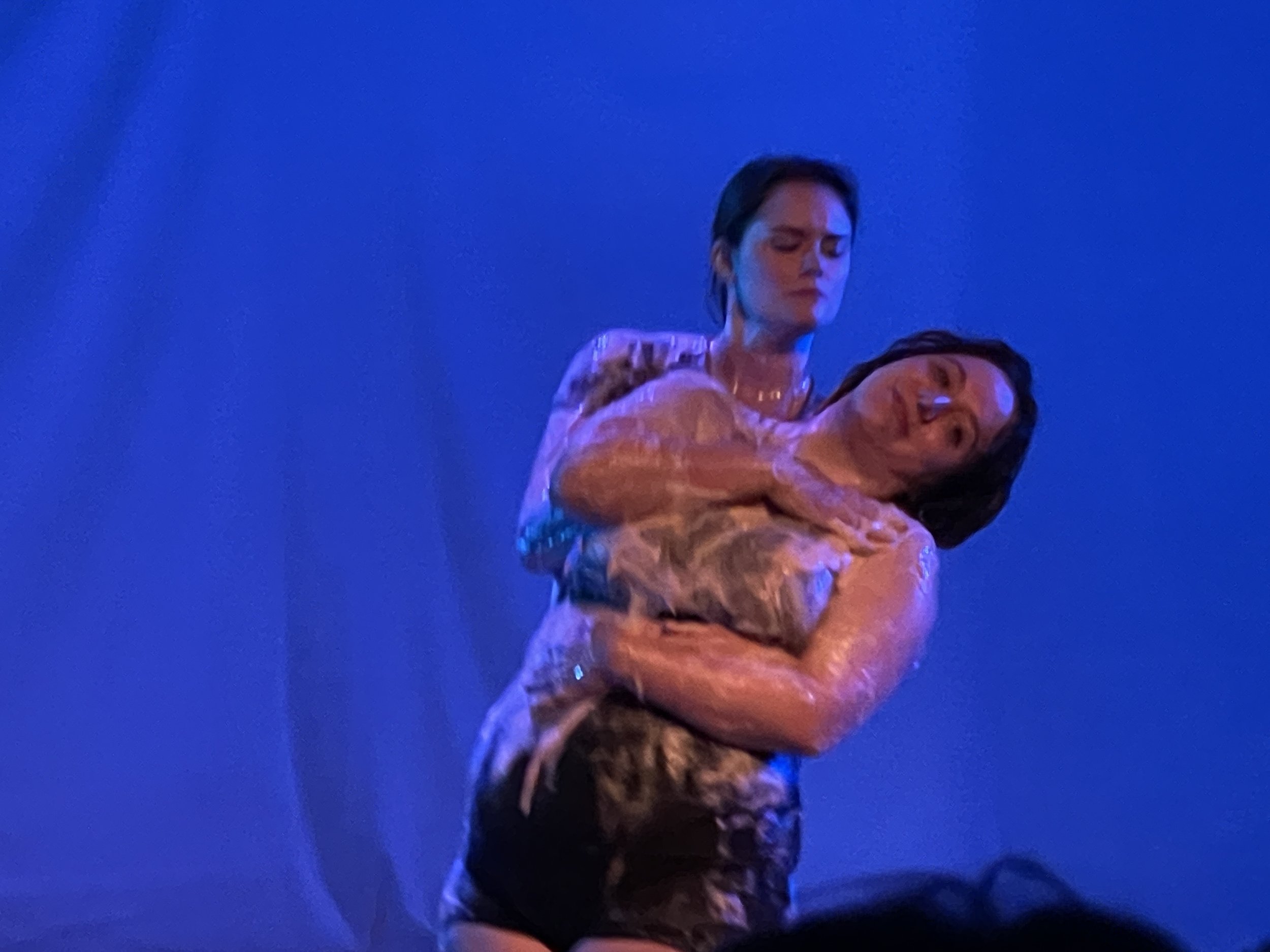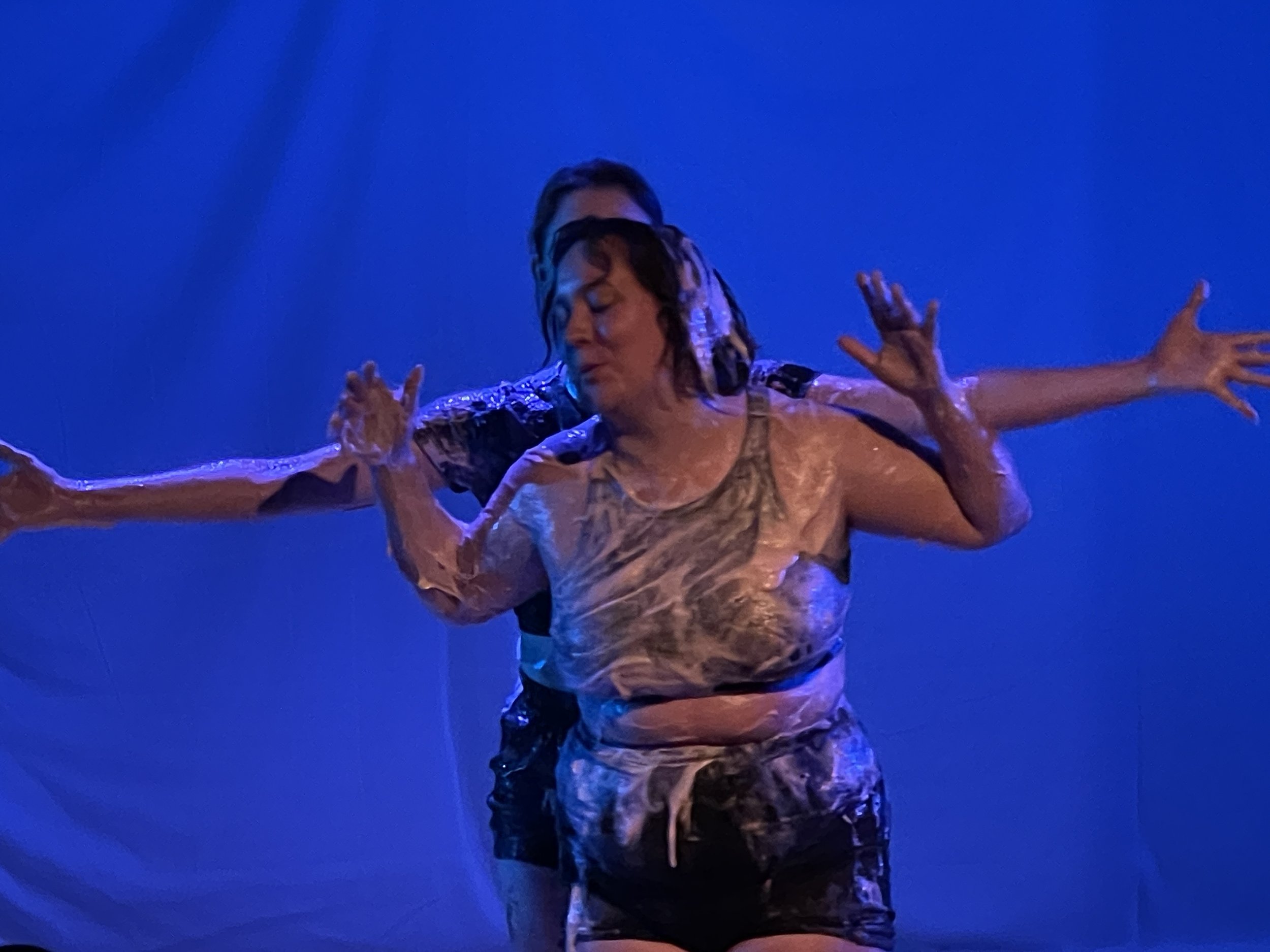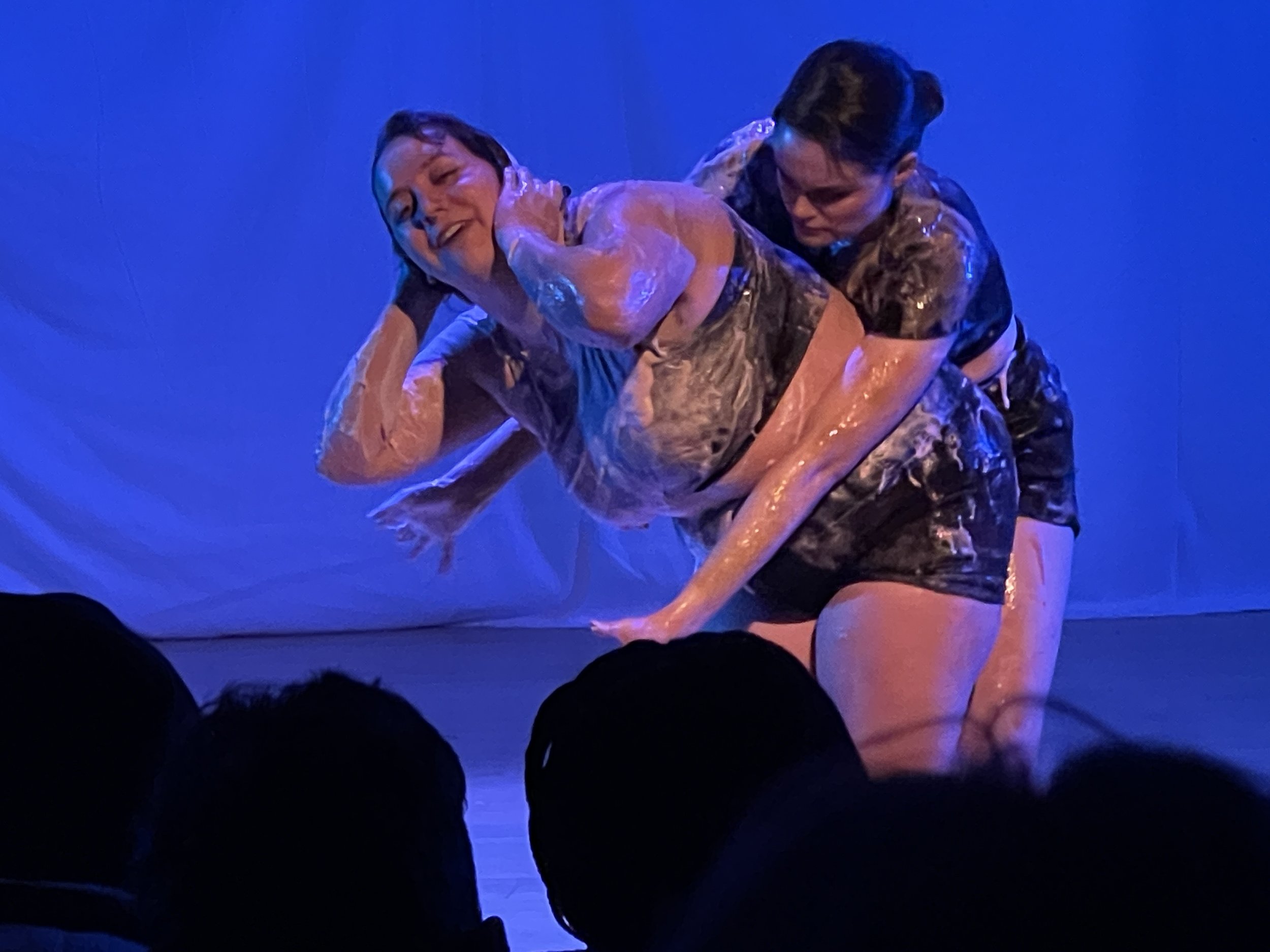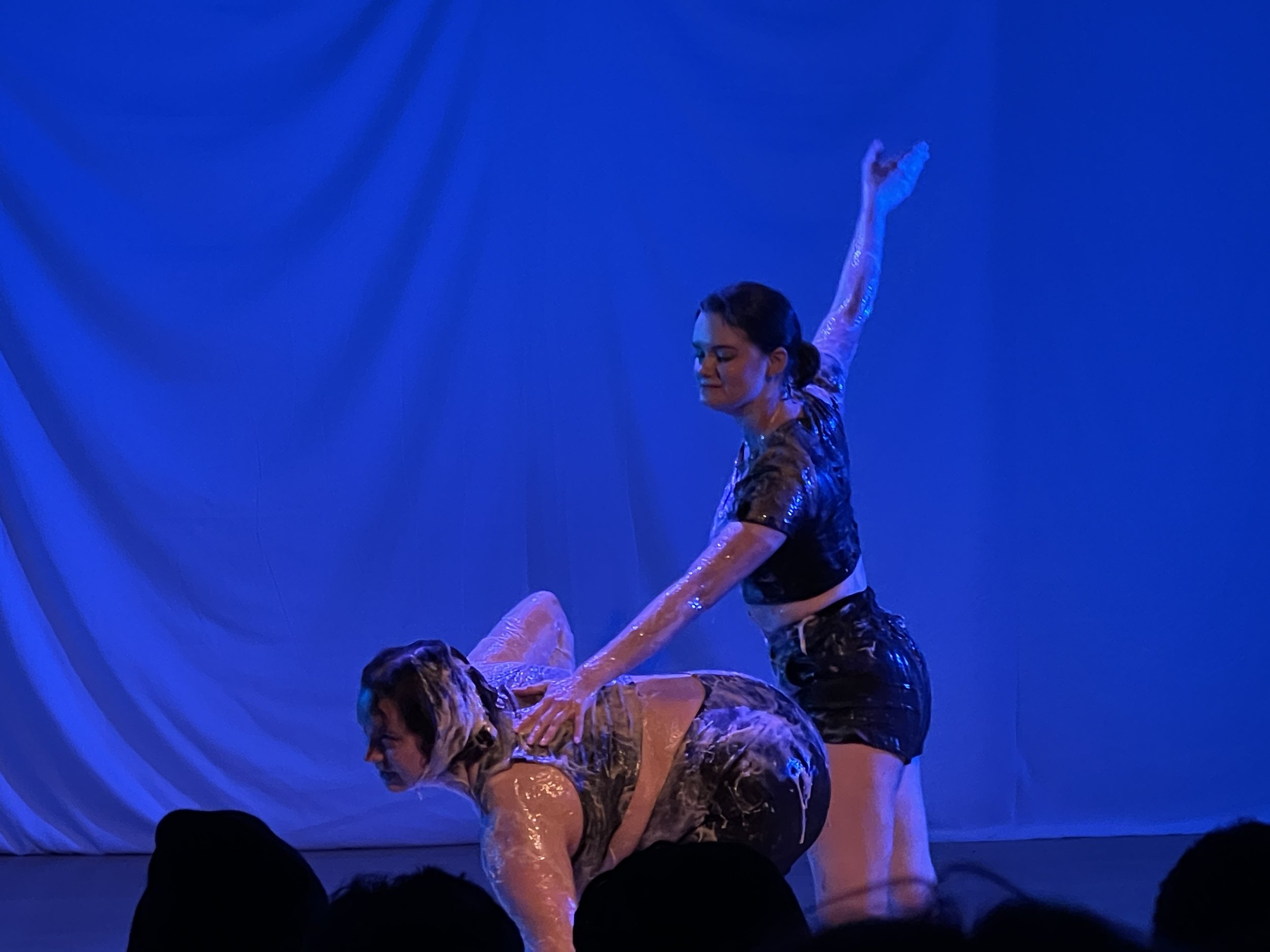REVIEW: “Milking the Beast and Going To Hell” by the Runaways Lab Theater at Links Hall
Stage settings for the play festival. Image courtesy Runaways Lab Theater and the artists. Photos by Michael Workman.
REVIEW
Milking the Beast and Going to Hell
Runaways Lab Theater
Links Hall
3111 N Western Ave.
Chicago IL 60611
December 8—10, 2023 (run completed)
By Michael Workman
Experimental theater in Chicago can sometimes feel constrained by prosceniums and routine when it’s not an immersive production or part of a Chicago Home Theater Festival kind of context which is, in part, how this production got its start. Or rather, how the Runaways Lab Theater got its start, under the direction of founder Olivia Lilley.
Prior to her Artistic Director role at Prop Thtr when I first met her through the Private Readings series (listen to an audio recording of her April 26, 2015 reading here), she was just starting to stage the living room productions of Faust that brought her early acclaim. Continuing on under the artistic direction of Jessie McCarty and Dylan Fahoome, “Milking the Beast and Going to Hell” is one of the early devised theater frameworks of the company that emerged when Gannon Reedy (who also performs in this iteration) was Artistic Director, alongside other memorable thought experiments including “Doing Drugs and Dying in Space” which dates back just as far.
Scene from “Resolution_7734.” Image courtesy Runaways Lab Theater and the artists. Videography by Michael Workman.
The bill featured a run of a dozen micro-plays, presented over two hours, with a brief intermission. It’s a welcome break in some ways from the reductive pandering, formulaic, strategic essentialist onslaught that has made so much unconvincing work the norm recently. Happily, these productions exist in the vein of performance that isn’t really meant to be described, little less have a pre-chewed broad-appeal context. In fact, they’re meant to stand as much as possible just beyond description, malingering just outside the bounds of any sort of immediate interpretation. In many ways, that’s the delight of devised theater and collective creation techniques themselves, existing as they do as a sort of challenge to reach beyond individual interpretation (and any rote, expected responses) to a prompt, and return from the beyond with little innovations on a given idea. In the case of “Milking the Beast,” the art-making process is further constrained by simplifying the general context of the action on display: in each instance, there must be some example of milking a beast, and of going to hell. Simple! As an added benefit Faust as continuing context is baked-in, you see. By design an experiment in outlandishly-imagined and often absurdist set pieces, results are intended to vary as widely as possible.
They’re all greatly entertaining, of course, and the festival opens with a hopeful act of apocatastasis. “Glot Goes to Heaven,” written by Jacob Favors and Hailie Keliuotis and directed by Jo JB Schaffer tells the tale of a demon who has labored in the bowels of hell, suffering amongst the damned, since the beginning. Performed by Jacque Bischoff, William Brown, Rachel Herriges, Brendan McInturff, Andrew Piechota and Electra Tremulis, Glot the demon is the laborer in a bureaucratic / administrative hellscape straight out of the Adult Swim channel’s Your Pretty Face is Going to Hell. Eventually visited by an angelic host who have decided he has “served his time,” this lower-caste hellfiend must decide if he has just become too institutionalized to leave.
Scene from “Meat.” Image courtesy Runaways Lab Theater and the artists. Photo by Michael Workman.
“Resolution_7734” features Fahoome in one of many curious cameo-esque performances, most often as some form of subjugant, including memorably as a pony boy in full BDSM regalia in “Bull,” written by Lucky Blaize and directed by Maddie Baird with Perry Letourneau and Erin Pierce-Spurrier, and later as some form of white-satin femme doll porno cosplay character, hands tied with silk bow-laces in “Cataloged for Restoration,” written by Max and Mitchell Rathberger, directed by McCarthy and with performances by Brown and Olivia Wheeler. Alongside Seph Mozes, he performs as one of two trees who spend most of the play discussing life goals, and when one decides to “become a parent” by sprouting an apple, Fahoome’s tree is jealous and snidely announces that it too, will follow suit and become a parent by sprouting its own apple. An arboreous co-depenency if ever there was one, the tree couple blindfold themsevles and are assailed by some form of “inner voices” — until Steak Richardson bursts shirtless onto the scene to “milk” three bananas and complete the fruit-bearing ritual.
Scenes from “Andromedusa.” Image courtesy the Runaways Lab Theater and the artists. Photos by Michael Workman.
Performed by Claire Metusalem and Tremulis, “Andromedusa” follows two entwined divine feminines, dripping white viscous fluid, who perform movement responses to a prolonged poetic recitation. Written by Mike Corran and directed by Stevie Stevens, the evocative language exchanged between the two centers on a meditation of fleshhhhh and, repeatedly in refrain, on the concept of a “wall of fleshhhh,” coded language that seems to hint at a hidden, cosmic significance which the two movers both embody and seem constantly amused by evading its definition.
In a parallel vein “Meat,” written by Dizzy Turek and directed by Natahsha Lasky, performed by Katie Bevil, Ellie Donnelly, Jenn Geiger, Kelly Hogan, Joshua Hoover, and Shea Leavis, starts off with the emergence of some form of masked cow god who prancingly reveals a crocheted sack of udders that Bevil and Donnely set gleefully to milking. This licentious abandon transitions to a sequence in which, magically transported to hell, they exist as two severed heads on a red silk table. As the women mock moan, groan and skriek in agony, Hoover carves from and serves their flesh to other cast members while an “Old Country Buffet” commercial from the 1980’s is projected in the background.
Scene from “Beasts of the Field.” Video courtesy Runaways Lab Theater and the artists. Videography by Michael Workman.
“Beasts of the Field,” written by Christopher Wormwood and directed by Niky Crawford presents Reedy as a sort of cowboy-hat-wearing redneck Doctor Who preacher / tour guide who starts off with a lecture tour of udder anatomies and Christian mythological tropes before introducing the audience to a series of hellbeasts — stuffed animals with altered anatomies and filled with milky-white substances — that he murders, tears open and drinks from to transport us all collectively to his version of hell — a Sarah McLaughlin ASPCA animal cruelty commercial from the ‘90’s.
[Side note: at one point in the play, Gannon explains, you can send a text — to the number in the photo at the end of this article — to receive your own hellscape demon character card sent to you — a service which works, sending you different demon trading cards each time.]
Scene from “Ür.” Image courtesy Runaways Lab Theater and the artists. Photo by Michael Workman.
After the intermission, “Ür,” written by Reed and directed by Dakota Brown, with superb sound work by Eric Breden, transports the scene into a post-apocalyptic setting centered on a massive, stitched — gloriously skin-textural — psionic flesh cube. Stumbled upon by a feral Dakota Brown who gallops in on all fours wearing nothing but a filthy pair of whitey-tighties, the dehumanized man and flesh cube begin to bond, until intervened on by Dylan Walker’s Ghillie-camo suited survivalist sniper, who takes over and speeds along a scene of psychic corruption, corrosion and decomposition.
Scene from “Dead Play.” Video courtesy Runaways Lab Theater and the artists. Videography by Michael Workman.
Near the end of the two-hour run, the eschatology culminates in an eruption of puppet theater with “Dead Play,” written and directed by Ash Barton, a charming, entrancing, too-brief production that depicts the imagined experience of a little girl’s crocheted Studio Ghibli boh mouse toy as it brings to life and heralds scene after scene populated with elaborate, exquisitely crafted two-dimensional creatures — birds, roaches, cows, serpentine Japanese dragons — held aloft and at times operated by hand, with movements performed collectively by Barton, Louie Hayes, B Laurent, Ryne Nardecchia and Kristen Wormwood.
Transportive and delightful, the two hours went by in an instant. Riffing cleverly on and flirting with ironic depictions of prevailing pop-culture themes, overtures to puncturing norms become their own way of reversing the Faustian bargain, with its frequent condemnations of banality and corporate dehumanization, of a rooted longing for a dimension where transcendent resplendence may prevail against the conformist impositions of biology and crass materiality. Wink, nod. Maybe not? Does it matter? Could be we’ve all just fell down the hole into the numbness of a bloody, grotesque, evil masscult American hell. Or maybe it’s just the mother’s milk of great fun, lo-fi fringe-of-center theater.
Michael Workman is the Editor-in-Chief of Bridge.
Like what you’re reading? Consider donating a few dollars to our writer’s fund and help us keep publishing every Monday.












